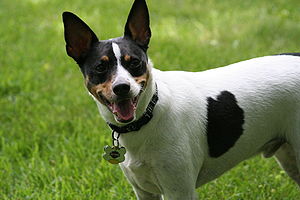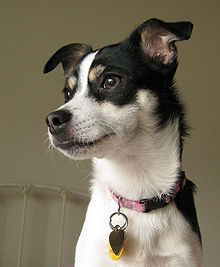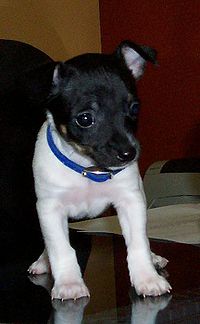Rat Terrier
The Rat Terrier is an American dog breed with a rich and varied background as an all-around farm dog. Traditionally more of a type than a breed they share much ancestry with the tough little mixed breed dogs known as "feists". Several private associations have maintained Rat Terriers registries for some decades, but more recently there have been movements to obtain breed recognition by the major canine organizations. Common throughout America on family farms in the 1920s and 30s, they are generally considered a rare breed[1]. Today's Rat Terrier is an intelligent, active little dog that is equally cherished as a house helper, vermin hunter and a family pet.
Contents
[hide]Description
Appearance
The Rat Terrier comes in a variety of coat colors and patterns. Puppies start at weight of 2 pounds. The "classic" base is black tanpoint with piebald spotting (known as "black tricolor"), but blue and brown tricolors are also common, along with red, sable, lemon, and other colors set off by varying amounts of white spotting. Ticking is usually visible in the white parts of the coat, or in the underlying skin. Brindle, currently disallowed by the main breed standards, is considered by some to be a "traditional" Rat Terrier pattern, and there is a growing movement to have this pattern accepted into the breed. However, merle is widely considered to be the result of recent outcrosses and, because of associated health problems, is rejected by most Rat Terrier breeders.[2] Ear carriage can be erect, tipped, or button, all of which contribute to an intelligent, alert expression. The tail has been traditionally docked to about 2–3 inches, but the bobtail gene is very common in Rat Terriers and can result in a variety of tail lengths. Today, some breeders prefer a natural, undocked tail, which is accepted in the breed standards.In the 1970s, a hairless mutation appeared in a single Rat Terrier bitch and was propagated into a strain of the Rat Terrier. After a period of development by crossing to coated dogs, the United Kennel Club (UKC) recognized the American Hairless Terrier as a separate breed in 2004.
The Rat Terrier ranges from about 10 to 25 pounds and stands 13 to 18 inches at the shoulder. The miniature size (13 inches and under as defined by the UKC) is becoming increasingly popular as a house pet and companion dog. A larger strain, often in excess of 25 pounds, has been developed. These "Deckers" or Decker Giants were named after breeder Milton Decker who created a larger hunting companion and are recognized by the National Rat Terrier Association (NRTA, see Breed recognition below). The NRTA recognizes a Toy Variety weighing 10 pounds or less, and continues to classify the Teddy Roosevelt Terrier as the Type B Rat Terrier.
Recently, a new registry has been started by Milton Decker, his son Ellis Decker, and a fellow hunting enthusiast, George Palmer called the Decker Hunting Terrier Registry, or DHTR.[3] This registry's mission is to keep all the qualities that set the Decker aside from the standard Rat Terrier, while retaining and improving upon the hunting ability. This registry believes that inbreeding forever will eventually ruin the breed and feels that very selective out-crossing is necessary to maintain a healthy gene pool as well as add desirable traits.
The Heritage Decker Terrier Registry[4] is preserving all the original bloodlines to this breed and will not be allowing out-crosses because the gene pool of registered dogs remains at 1,400 at present. Many breeders are working to preserve exactly what was established in the 1970s, a great all around working dog.
Although both registries have different opinions about out-crossing, both registries are working to preserve what they feel is best for the future of the breed.
Temperament
Although often mistaken for a Jack Russell Terrier, the Rat Terrier has a different profile and a very different temperament. Rat Terriers are finer of bone and have a more refined head. They always have a short single coat, i.e., they are never wire coated.
History
The breed name comes from the occupation of its earliest ancestors; brought to the US by working class British migrants, these quick, tough little dogs gained their fame in rat pit gambling. However they were, for the most part, bred for speed. Their speed is used for controlling vermin and hunting squirrels, hare, and other small game. Like all terriers of this type, Rat Terriers most likely developed from crosses among breeds like the English White Terrier, Manchester Terrier, Smooth Fox Terrier, and Whippet. After the 1890s, as the breed type became popular in America, other breeds were added to the mix. Beagle, Italian Greyhounds, Miniature Pinschers, and Chihuahuas were likely used to add scenting ability, speed, and smaller size. Many of the foundation Rat Terriers were indistinguishable from small mixed-breed hunting dogs known as "feists". The smaller varieties were split off from the Rat Terrier very early on, registered by the UKC as the Toy Fox Terrier beginning in 1936.
Rat Terriers were cherished as loyal and efficient killers of vermin on 20th century American Farms, as well as excellent hunting companions. As a result they were one of the most popular dog types from the 1920s to the 1940s. However the widespread use of chemical pesticides and the growth of commercial farming led to a sharp decline in the breed from the 1950s onwards. Fortunately breed loyalists maintained the bloodline, leading to the modern Rat Terrier we enjoy today.
The genetic diversity of the Rat Terrier is undoubtedly its greatest asset, and is responsible for the overall health, keen intelligence, and soundness of the breed. Most modern breeds were developed from a few founding dogs and then propagated from a closed gene pool. In contrast, the Rat Terrier has benefited from a long history of refinement with regular outcrosses to bring in useful qualities and genetic variability.
Breed recognition
Rat Terrier organizations exhibit the typical disputes over the course of action to be taken for the promotion and preservation of the breed. As usual among working breeds, points of departure are which dog type best represents the breed and whether the dog's working qualities will be sacrificed to selection for conformation show competition. Perhaps because the Rat Terrier has existed for decades with several evident types upheld by different clubs, disagreements can be highly charged. It seems safe to say however that even farm-bred Rat Terriers have been cherished as much for their smart, amusing, and trainable companion qualities as for their skills at eradicating rats and hunting small game. Thus it is not surprising to see increasing numbers of Rat Terriers excelling at performance sports such as agility, rally, and obedience.
The UKC officially recognized the breed on January 1, 1999. The Rat Terrier Club of America is actively working toward recognition by the American Kennel Club and the breed was accepted into the AKC's Foundation Stock Service in 2005. The first Rat Terrier to earn a title under AKC Sanctioning was in Agility on January 14, 2006 in Van Nuys, California.
Rat catching
There is nothing better than a rat terrier type dog for getting rid of mice and rats! They are usually considered more efficient at killing rats than cats are. The good thing about rat dogs is they don't eat them, they don't play with them, they don't feel to need to bring them up on the porch as a present for you,they just shake the snot out of them and go on to the next one. And they can do this all night every night for ever! They are also small dogs that can get into very small places.
References
- Jump up ↑ Kummer 2006.
- Jump up ↑ [1]
- Jump up ↑ http://deckerhuntingterrierregistry.com/
- Jump up ↑ http://www.heritagedeckerterrierregistry.com/
External links
- National Rat Terrier Association
- Rat Terrier Club of America
- New Rattitude, Inc. National Rat Terrier Rescue & Adoption
- Rat Terrier ResQ, Inc. National Rat Terrier Rescue and Adoption
- Ratbone Rescues, Inc. National Rat Terrier Rescue & Adoption
- WY Rat Terriers Rescue Rat Terrier Rescue & Adoption


